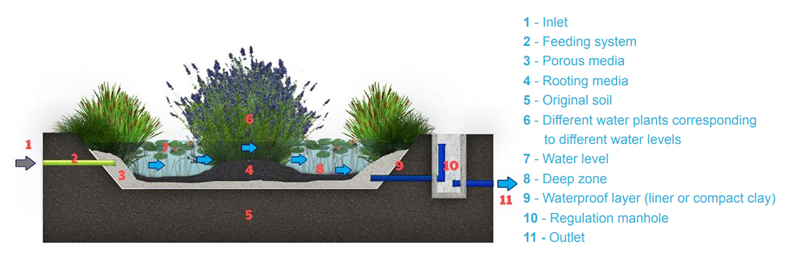- Mitigation title
- Free water surface treatment wetlands
-

- Description
-
Sometimes also known as constructed wetlands these are the most similar to natural occurring wetlands. Free water surface wetlands are mostly used for tertiary treatment and are ‘self-contained’ from the surrounding land with an impermeable liner, natural or synthetic.
The wetland can hold a volume of water (from 0.5 to 1 metre deep) with various types of aquatic wetland plants, which could be submerged or floating. The plants act as the substrate in this case and incorporate nitrogen and phosphorus.
These wetlands use a mix of aerobic and anoxic reactions, as well as phytodegradation to achieve treatment. This is the type of mitigation that Herefordshire Council has used as part of its Phosphate Credit Scheme.
- Advantages
-
- Reuses water
- Can be fed by gravity (low energy use)
- Biodiversity enhancement
- Carbon sequestration
- Of aesthetic value
- Flood mitigation
- Disadvantages
-
- Requires primary/secondary treatment
- Potential mosquito habitat
- Parameters
-
- Phosphorus
- Ammonia
- Nitrogen
- BOD/COD
- Carbon footprint
-
- Short term energy requirements for earth works
- These wetlands act as a net carbon sink
- Time to become effective
-
- Gravel filtration will immediately remove suspended sediment
- Removal of nutrients / organic matter will first need vegetation to become established
- Maintenance
-
- Sediment build up needs to be removed from wetland as required, may require replanting
- Suggested cutting back of plants and removal of litter as required
- Performance with time
-
- Performance can be kept at optimum with well a well-established maintenance schedule
- Performance fluctuates with seasonal changes; lower in autumn/winter, highest in spring/summer
- Scaling considerations
-
The size of the wetland is correlated to the load of nutrient removal. Design criteria to meet:
- Monitoring required of the inlet and outlet concentrations and a Population Equivalent must be evidenced
- Hydraulic and mass loading will directly impact sizing, aspect ratio, and depth
- Must take into account climate factors and climate change, such as droughts and dry weather, or water gains from rainfall, etc. As well seasonal dynamics and differences in flows through different seasons
- Must take into account seasonal efficiency tied to plant growth
- Ecology and plant community; what plant species to use
- References
-
Alexandros Stefanakis, C. S. (2014). Vertical Flow Constructed Wetlands. Eco-engineering Systems for Wastewater and Sludge Treatment.
Dotro, G., G Langergraber, Pascal Molle, Nivala, J., Jaume Puigagut Juárez, Stein, O.R., Marcos Von Sperling and Iwa. (2017). Task Group On Mainstreaming The Use Of Treatment Wetlands . Treatment wetlands. London: Iwa Publishing.
ICRA. (n.d.). Free Water Surface Treatment Wetlands.
Natural England. (2022). Framework Approach for Responding to Wetland Mitigation Proposals.
Ricardo for Herefordshire Council. (2021). Interim Phosphate Delivery Plan Stage 2, Mitigation options for phosphate removal in the Wye Catchment.
Silviya Lavrova, B. K. (2013). Nutrients and Organic Matter Removal in a Vertical-Flow Constructed Wetland. Applied Bioremediation.
Wetland Engineering. (n.d.). Treatment Wetlands. Retrieved from https://wetlandengineering.co.uk/treatment-wetlands
